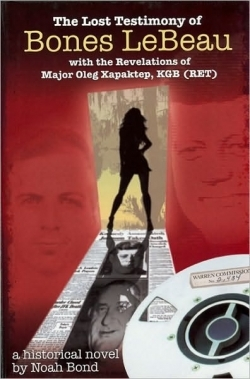It looks like you've stumbled upon a page meant to be read by our code instead of viewed directly. You're probably looking for this page.
The Lost Testimony of Bones LeBeau
The preponderance of literature on the subject of President Kennedy’s assassination is vast. Ever since Mark Lane’s Rush to Judgment seriously questioned the Warren Commission’s lone gunman theory, the door swung wide open to speculative conspiracy theories. Decades after the assassination, government committees officially conceded that a conspiracy existed, but added that no conclusive evidence could be found. Theorists have implicated everyone from Jimmy Hoffa to Castro to the CIA. In his latest novel, The Lost Testimony of Bones LeBeau, Noah Bond has created a chilling version of a plot by the mob to kill the president. Bond has authored NOMAD/Y: The Moonbase Project and a number of screenplays.
Surprisingly, the tale’s central character and narrator is a woman who unwittingly finds work with the mob. Fresh out of high school, deep in Cajun country, Bones LeBeau ventures to New Orleans in the spring of 1963 to seek fortune and fame. She stumbles upon a waitress-stripper job at a restaurant owned by a mobster. Unsuspectingly, she goes about her business chatting and entertaining the team of collaborators hatching a plot to assassinate the president. Enter Mr. Carlos, Mr. Dave, Mr. Santos, Mr. Leon, and Mr. Jack, who some readers will, in time, identify as real-life historical figures, i.e., members of organized crime and spies and underworld characters implicated by conspiracy theorists. What sets this book apart from others like it (DeLillo’s Libra and Mailer’s Oswald’s Tale), is the use of a purely fictional character—an invention—who keeps close company with the collaborators leading up to that fateful day in Dallas. In so doing, the story moves along in an eerie and hypnotic fashion. The plot recalls Shakespeare’s Julius Caesar with Mr. Leon and Mr. Dave taking on the roles of Caesar’s assassins. Instead of the shadowy streets of ancient Rome, the plot is set in the seedy back room of a New Orleans restaurant.
Having researched many source materials on the assassination (the Warren Commission, published FBI files, KGB memos, and countless novels and journalistic reports), the author took the stale facts, archived testimony, and anecdotes and turned them into something altogether different, especially in recreating the voices of the conspirators to simulate real-life players in the plot. The author weaves fact and fiction for dramatic effect so that readers aren’t bogged down by a myriad of facts. For readers unacquainted with the conspiracy theories, the story is seductive with its ambiguity to keep them wondering what is unfolding, while to those convinced that Oswald did not act alone, the book is equally compelling and will be a welcome addition to their conspiracy theories library. At the end, the author adds a twist with a shocking memo by a Soviet KGB agent who shares his own revelations. After arguing that Kennedy had a long list of enemies, the agent exposes the complicity of forces at work, and the real reason the president was assassinated.
Reviewed by
Gary Klinga
Disclosure: This article is not an endorsement, but a review. The publisher of this book provided free copies of the book and paid a small fee to have their book reviewed by a professional reviewer. Foreword Reviews and Clarion Reviews make no guarantee that the publisher will receive a positive review. Foreword Magazine, Inc. is disclosing this in accordance with the Federal Trade Commission’s 16 CFR, Part 255.
